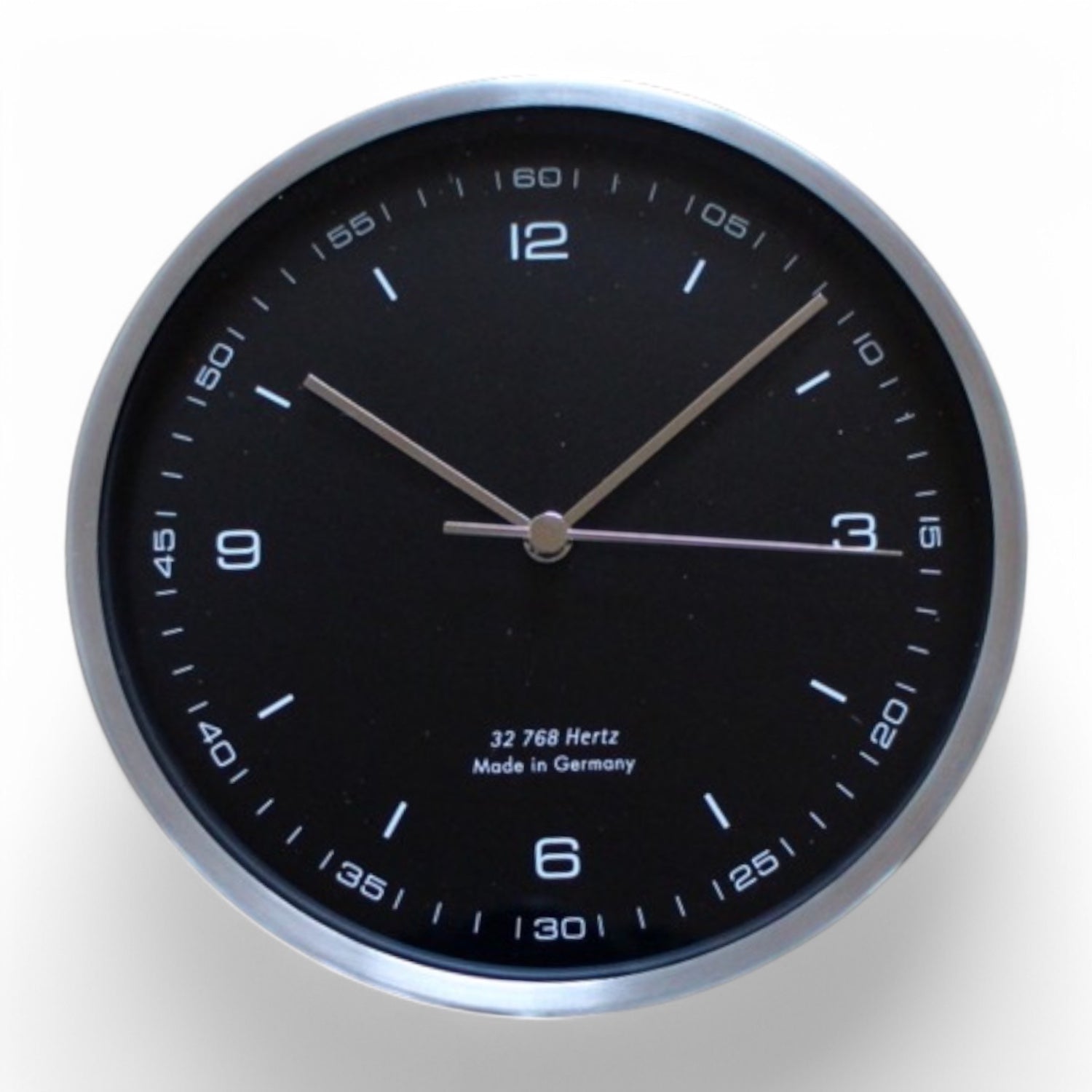Voor wie op zoek is naar een stijlvolle en complete maritieme set, is deze combinatie van de Barigo 650MBL quartz klok en de 350MBL baro-thermo-hygrometer een schot in de roos. Beide instrumenten zijn uitgevoerd in geborsteld roestvrij staal met een elegante zwarte wijzerplaat en witte Arabische cijfers, wat zorgt voor een moderne, nautische uitstraling die zowel aan boord als thuis perfect tot zijn recht komt. Ideaal voor jachten en moderne interieurs. Met een royale diameter van 162 mm en een duidelijke analoge weergave zijn deze instrumenten niet alleen functioneel, maar ook een echte blikvanger. De combinatie van een nauwkeurig quartz uurwerk en een mechanisch weerstation met de functie van een barometer, hygrometer en thermometer in één, garandeert betrouwbaarheid en gebruiksgemak. Dankzij het handige montagesysteem, de openingen aan de achterzijde, zijn beide eenvoudig aan de wand te installeren. Gemaakt in Duitsland en voorzien van hoogwaardige materialen zoals mineraalglas en RVS, is dit duo een duurzame investering voor liefhebbers van precisie, maritiem design en vakmanschap. Een geliefde set onder booteigenaren en yacht liefhebbers, gewaardeerd om zijn stijlvolle uitstraling, betrouwbare techniek en tijdloze maritieme klasse.
Scheepsklokken die de oceaan trotseren
Onze collectie scheepsklokken: van nautische pronkstukken voor aan boord tot moderne, tijdloze klokken voor thuis. Voeg maritieme luxe toe aan je interieur op de boot of in huis, en houd de tijd in stijl bij – voor trotse zeemannen en matrozen die van een stijlvol interieur houden. Van traditionele mechanische klokken die je eenvoudig opwindt, tot getijden klokken die je helpen bij navigatie, onze scheepsklokken zijn zowel praktisch als esthetisch. Gemaakt van hoogwaardige materialen zoals messing, RVS en verchroomd messing, zijn ze bestand tegen de uitdagingen van het leven op zee. Kies uit diverse ontwerpen en formaten, van klassieke patrijspoort scheepsklokken tot moderne, sportieve stijlen. Wat past bij jou?
59 producten
59 producten
Sorteer op:
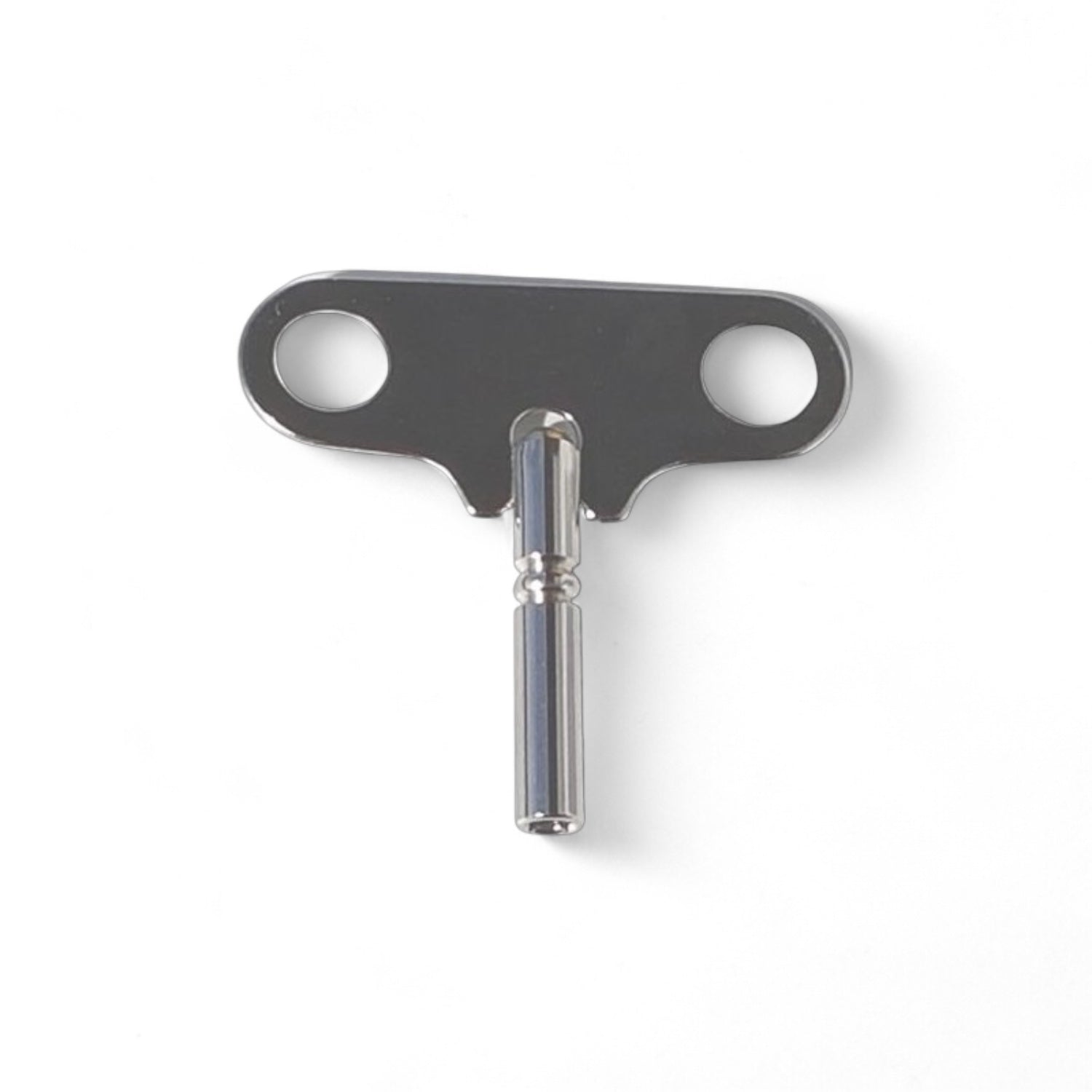

Opwindsleutel voor mechanische scheepsklok, 2 beschikbare maten
€19,00
Eenheid prijs PerOpwindsleutel voor mechanische scheepsklok, 2 beschikbare maten
€19,00
Eenheid prijs PerZoek je een nieuwe opwindsleutel voor je mechanische scheepsklok? Bij Studio Maritime vind je de juiste sleutel, speciaal ontworpen voor merken zoals Schatz, Wempe, Barigo, en Weems & Plath. Met twee beschikbare maten bieden we een oplossing voor zowel moderne als klassieke mechanische scheepsklokken.
De 3,1 mm sleutel is perfect voor scheepsklokken met het Hermle-uurwerk (type W0132.071), een veelvoorkomend mechanisme bij bovengenoemde gerenommeerde merken. Heb je een oudere scheepsklok? Dan is de 4 mm sleutel de juiste keuze, ideaal voor klokken met een grotere diameter.
Twijfel je over de juiste maat? Onze deskundige klantenservice staat voor je klaar om je te helpen. Zo weet je zeker dat je een sleutel kiest die perfect past bij jouw klok. Ontdek onze selectie en houd jouw scheepsklok in topconditie.
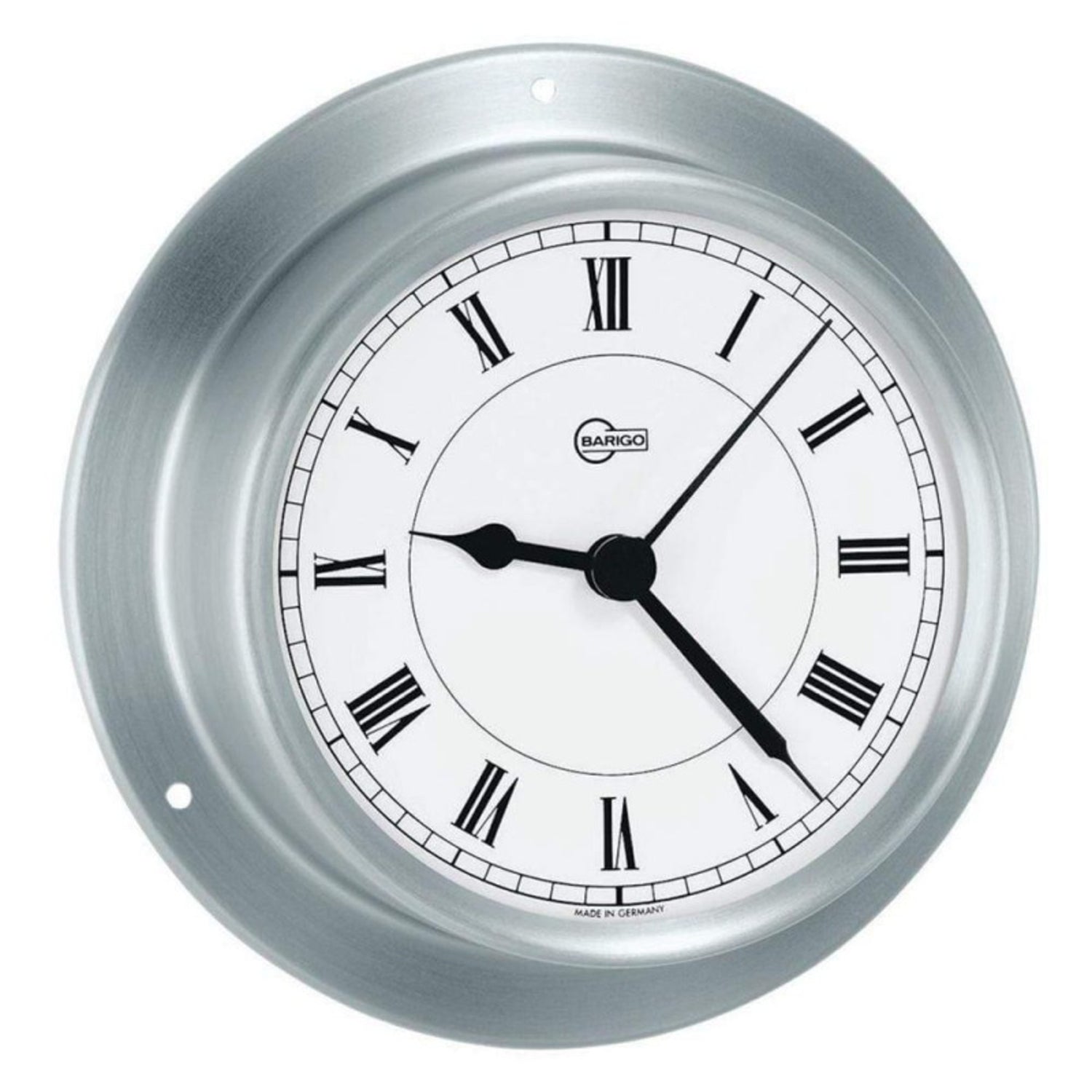

Barigo Sky quartz scheepsklok 110 x 32 mm – Romeins, geborsteld rvs
€107,00
Eenheid prijs PerBarigo Sky quartz scheepsklok 110 x 32 mm – Romeins, geborsteld rvs
€107,00
Eenheid prijs PerEen klok die niet alleen de tijd aangeeft, maar ook stijl toevoegt aan je interieur aan boord. De Barigo Sky Quartz scheepsklok is gemaakt van geborsteld roestvrij staal: luxe, duurzaam en bestand tegen de maritieme omgeving.
Dankzij de heldere witte wijzerplaat met zwarte cijfers lees je de tijd in één oogopslag af, ook bij minder licht. Het compacte formaat van 110mm behuizing en 85 mm wijzerplaat, maakt deze klok ideaal voor gebruik op de boot, maar ook passend in een maritiem ingerichte woning. Het betrouwbare Quartz uurwerk loopt op een standaard AA-batterij en vraagt nauwelijks onderhoud. En hij is een lichtgewicht om op te hangen, weliswaar 145 gram.
Waarom kiezen voor de Barigo Sky scheepsklok?
-
Geborsteld RVS – stijlvol en roestvast
-
Witte wijzerplaat met zwarte cijfers – maximale leesbaarheid
-
Compact en lichtgewicht – ideaal aan boord
-
Quartz uurwerk – betrouwbaar en onderhoudsarm
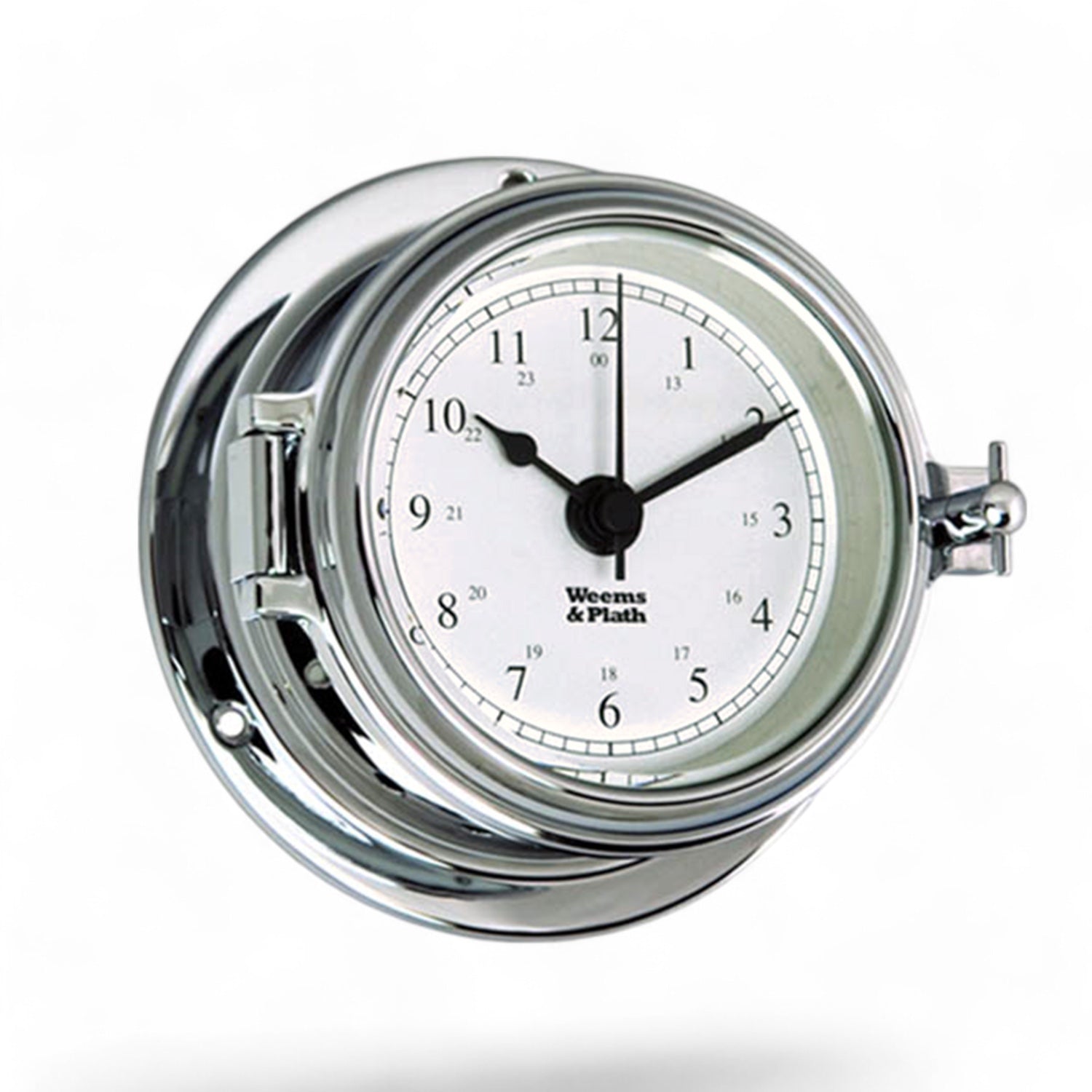
Endurance II scheepsklok - quartz, elegant met patrijspoort opening
Vanaf €179,95
Eenheid prijs PerEndurance II scheepsklok - quartz, elegant met patrijspoort opening
Vanaf €179,95
Eenheid prijs PerDe Endurance II Quartz scheepsklok van Weems & Plath biedt de perfecte balans tussen elegantie en functionaliteit. Met zijn klassieke patrijspoortontwerp, een handige vooropening, en onderhoudsvrije afwerking van hoogglanzend messing is deze klok een nautisch hoogstandje. De witte wijzerplaat met zwarte Arabische cijfers zorgt voor een heldere en nauwkeurige tijdweergave. Verkrijgbaar in drie formaten (120 mm, 150 mm en 180 mm), is deze klok weerbestendig en bestand tegen krassen of verkleuring, waardoor hij jarenlang zijn schoonheid behoudt. Het betrouwbare quartz uurwerk biedt eenvoud in afstelling en batterijwissel, dankzij de handige vooropening. Of je nu op zee bent of de klok in je huis pronkt, de Endurance II Scheepsklok is een iconisch sieraad dat maritieme tradities eert met moderne precisie.
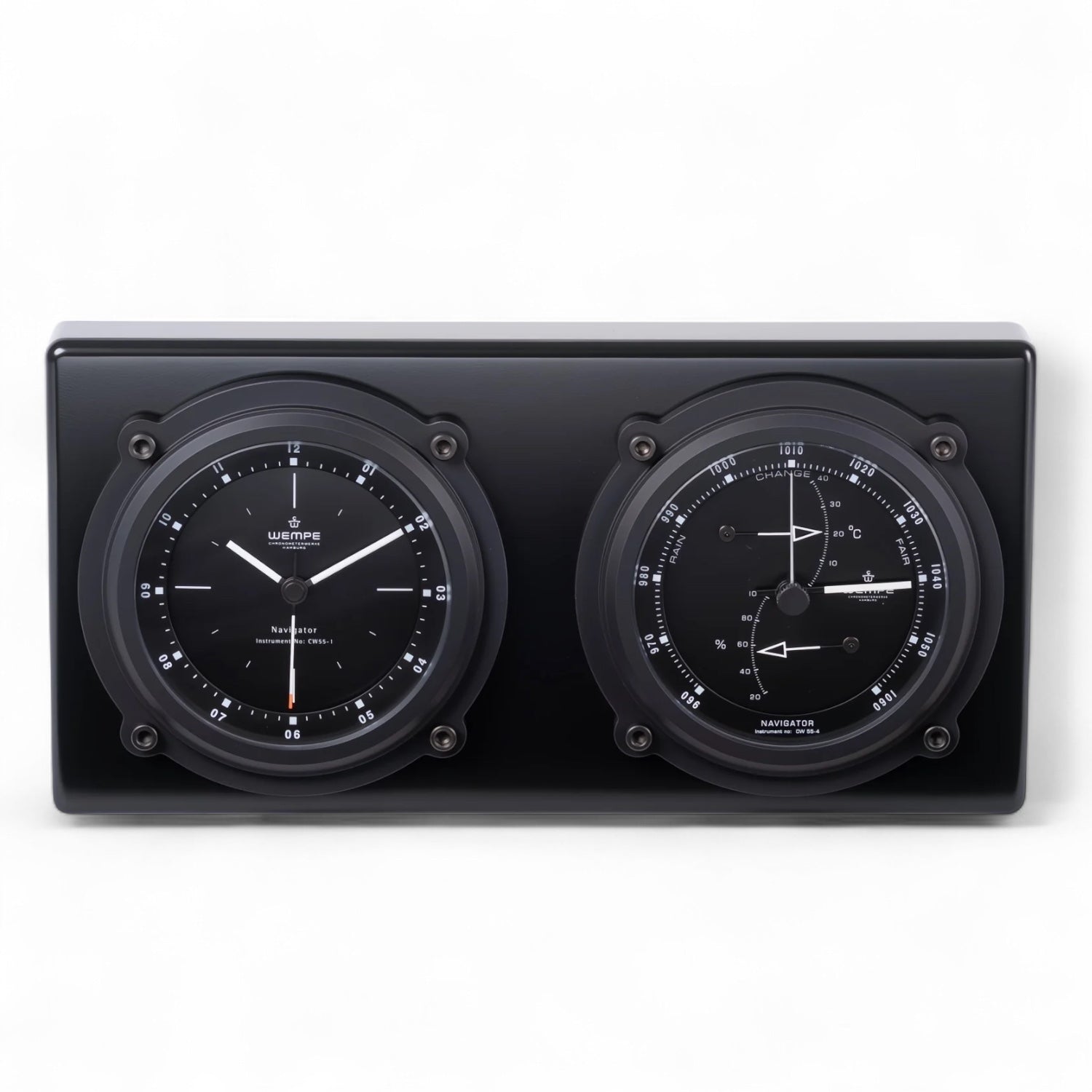
Wempe Navigator II combinatie-instrument - klok, weerstation, zwart aluminium, rechthoekig
€2.495,00
Eenheid prijs PerWempe Navigator II combinatie-instrument - klok, weerstation, zwart aluminium, rechthoekig
€2.495,00
Eenheid prijs PerDe Wempe Navigator II is een rechthoekig alles-in-één station met een quartz klok, barometer, thermometer en hygrometer, verpakt in een elegante, zwart geanodiseerde behuizing op een 55 mm dik zwart houten bord. Het gestraalde aluminium frame en de matte afwerking geven het een moderne, verfijnde uitstraling. Met een afmeting van 130 mm en een wijzerplaat van 100 mm biedt het nauwkeurige quartz uurwerk betrouwbare tijdmeting, terwijl de geïntegreerde barometer, thermometer en hygrometer maritieme precisie leveren. De lichtgevende wijzers en duidelijke wijzerplaat zorgen voor optimale afleesbaarheid, zelfs bij weinig licht.
Dankzij het praktische rechthoekige ontwerp kun je de Navigator II scheepsklok en het weerstation eenvoudig in één keer ophangen. Of met de extra meegeleverde pinnen neer te zetten op een kantoor of bureau in huis. Deze set is de perfecte keuze voor zowel aan boord als in luxe interieurs en vormt een statement van functionaliteit en stijl. Vervaardigd in Duitsland, biedt de Navigator II de ultieme combinatie van design en technologie. Perfect voor zeilliefhebbers, maritieme fans en als indrukwekkend
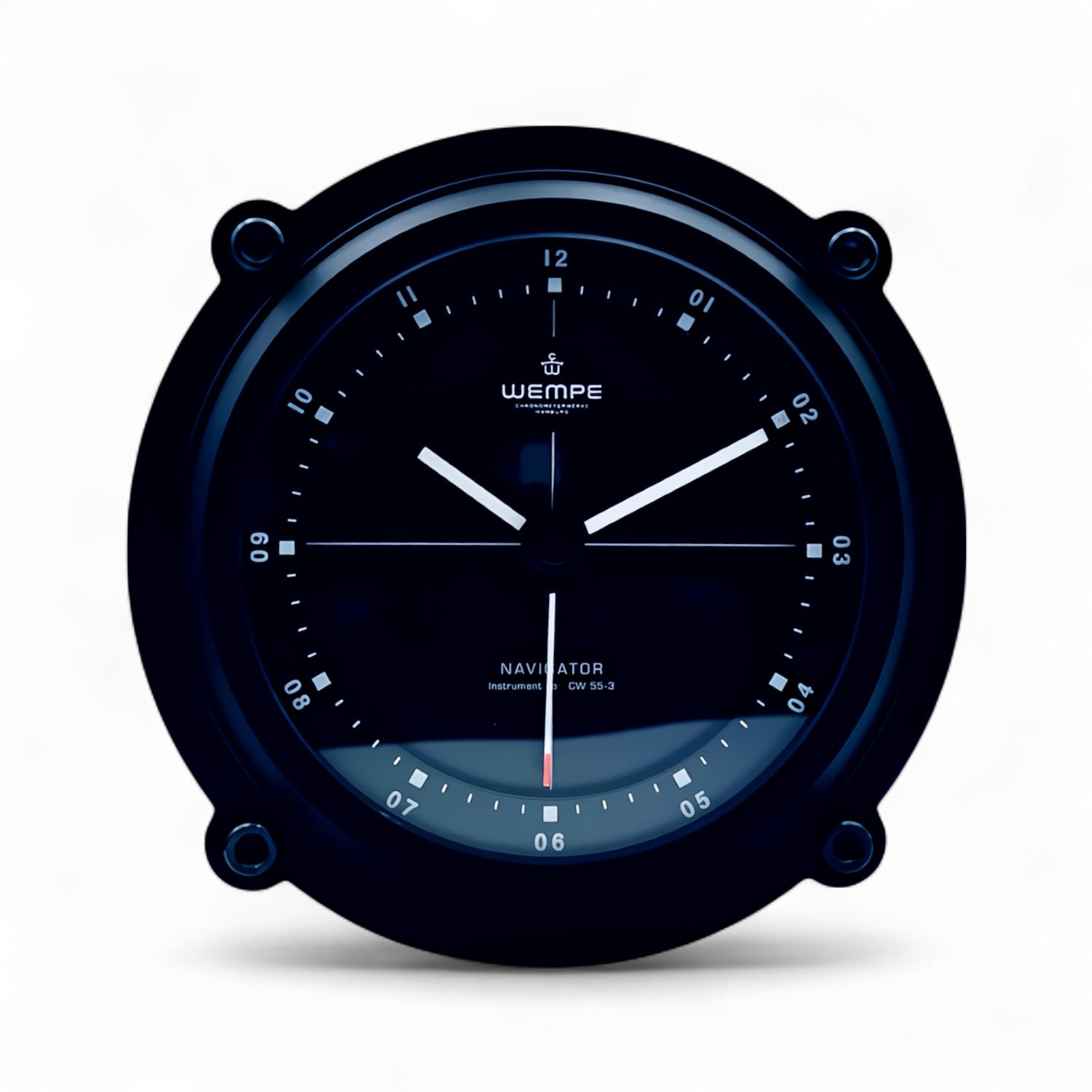
Wempe Navigator II scheepsklok – 130 x 65 mm, zwart aluminium, moderne luxe en precisie
€1.695,00
Eenheid prijs PerWempe Navigator II scheepsklok – 130 x 65 mm, zwart aluminium, moderne luxe en precisie
€1.695,00
Eenheid prijs PerDeze robuuste klok met combinatie-instrument heeft een riant formaat van 130 mm met een 100 mm wijzerplaat, zodat je vanuit de kajuit eenvoudig de weersomstandigheden, voorspellingen en tijd kunt aflezen. De witte Arabische LumiNova-indexen zorgen voor optimale leesbaarheid en lichten op in het donker, ideaal voor gebruik op zee. De luxe uitstraling wordt versterkt door een zwevende secondewijzer, terwijl de (mat) zwarte geanodiseerde aluminium behuizing een stoere, moderne look biedt. Het betrouwbare Japanse Quartz uurwerk garandeert precisie, en het praktische ophangsysteem met schroefopeningen aan de achterzijde maakt installatie eenvoudig. Een perfecte combinatie van stijl en functionaliteit voor aan boord.

Barigo 601.5 klok 104 x 30 mm – Pentable Collectie, vernikkeld messing, quartz precisie
€349,00
Eenheid prijs PerBarigo 601.5 klok 104 x 30 mm – Pentable Collectie, vernikkeld messing, quartz precisie
€349,00
Eenheid prijs PerDe Barigo 601.5 marine klok is een uniek exemplaar uit de exclusieve Pentable Collectie, waar vakmanschap en design elkaar perfect aanvullen. Deze klok is ontworpen voor mensen die oog hebben voor detail en waardering voor tijdloze maritieme stijl.
De zwarte wijzerplaat met witte cijfers biedt een helder contrast, zodat de tijd ook van afstand uitstekend leesbaar is. Achter het minimalistische design schuilt Duitse precisie: het betrouwbare quartz-mechanisme garandeert nauwkeurige tijdwaarneming, dag na dag.
Het vernikkelde messing frame is licht, duurzaam en bestand tegen corrosie en dat is ideaal voor aan boord, in huis of op kantoor. De compacte vorm maakt montage eenvoudig, terwijl de glanzende afwerking de klok een luxe uitstraling geeft die past bij elk interieur.
Waarom kiezen voor de Barigo 601.5 marine klok?
- Uniek design uit de Pentable Collectie: maritiem, modern en exclusief.
- Duitse precisie: quartz-mechanisme voor betrouwbare tijdweergave.
- Roestvrij & duurzaam: vernikkeld messing, bestand tegen zeelucht en vocht.
- Compact & elegant: Ø 104 mm, eenvoudig te monteren.
- Perfect te combineren: vormt een harmonieus geheel met andere Barigo-instrumenten.
Een stijlvol statement op zichzelf, maar ook prachtig te combineren met andere instrumenten uit de Barigo Pentable serie, zoals het weerstation. Stijl, precisie en karakter op zee én aan wal.
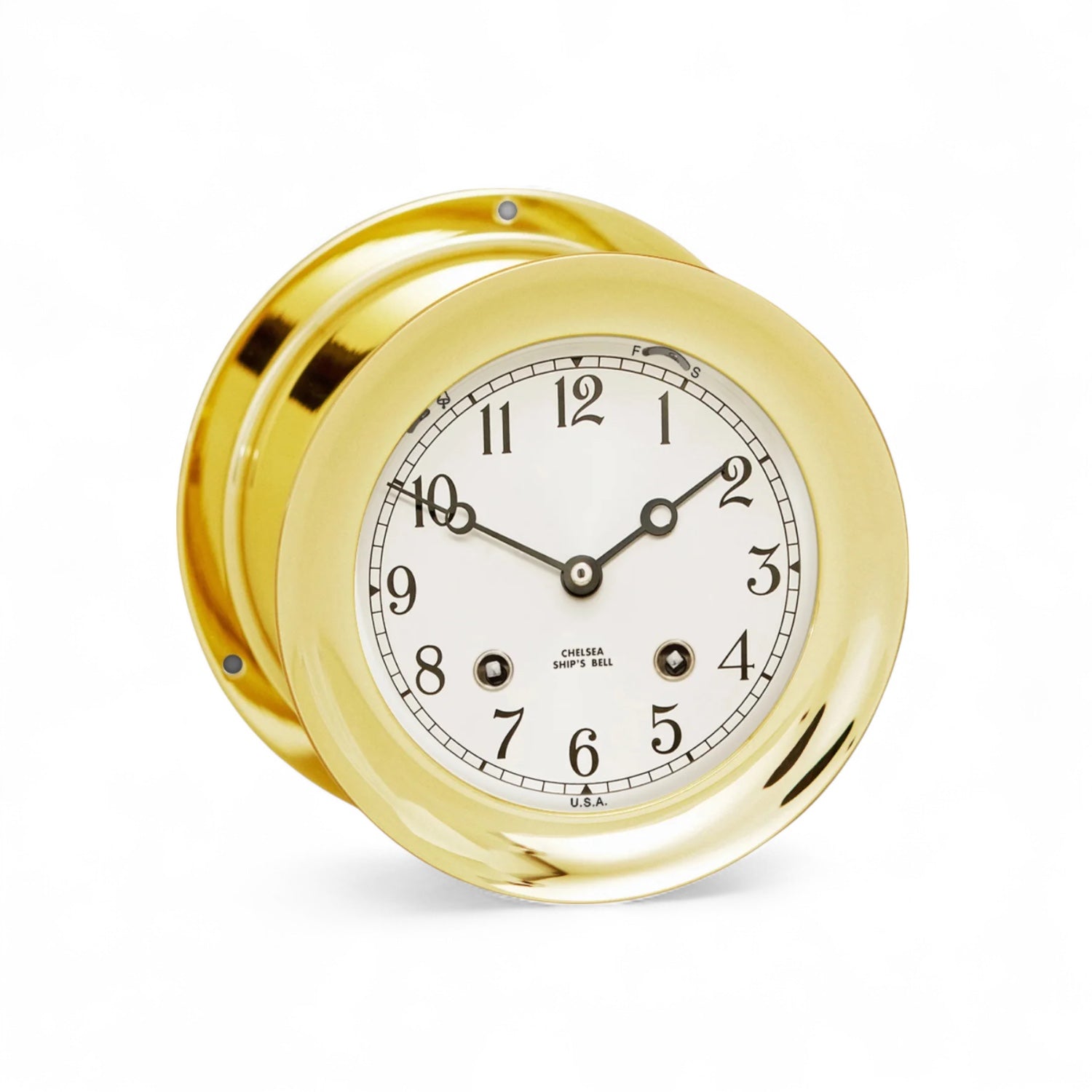
Chelsea Clock mechanische scheepsklok – messing, scheepsbel, luxe, 3 maten
Vanaf €3.790,00
Eenheid prijs PerChelsea Clock mechanische scheepsklok – messing, scheepsbel, luxe, 3 maten
Vanaf €3.790,00
Eenheid prijs PerZoek je luxe en maritieme geschiedenis, dan kies je voor de Chelsea Clock mechanische scheepsklok met scheepsbel. Deze klok uit de befaamde Ship’s Bell-serie is verkrijgbaar in drie formaten: 4,5 inch (11,4 cm), 6 inch (15,2 cm) en 8,5 inch (21,6 cm).
Wat deze klok zo uitzonderlijk maakt, is niet alleen het geluid, maar vooral de kunst van het mechanisme. Achter de verfijnde, hand-verzilverde wijzerplaat gaat een ambachtelijk binnenwerk schuil, opgebouwd uit maar liefst 290 messing onderdelen en voorzien van een 11-jewel beweging. Het resultaat: een uurwerk dat niet alleen uiterst nauwkeurig is, maar ook ontworpen is om generaties te doorstaan – kortom, een erfstuk in de ware zin van het woord.
Elke dertig minuten weerklinkt een warme, volle belslag volgens het klassieke vier-urensysteem van de marine. Acht slagen markeren het einde van de wacht (om 4, 8 en 12 uur), met daartussen oplopende beltonen per half uur. Het is een akoestisch ritueel dat niet alleen de tijd markeert, maar ook een ritme aan de dag geeft – een prachtige herinnering aan eeuwenoude scheepstraditie.
De behuizing is vervaardigd uit massief gepolijst messing, met een scharnierende bezel voor eenvoudige toegang bij onderhoud en het opwinden. De verfijnde afwerking tilt dit instrument naar een niveau waarop het moeiteloos tot zijn recht komt in zowel klassieke salons als moderne interieurs.
Dit maakt de Ship’s Bell Clock bij uitstek geschikt als huwelijkscadeau, stijlvol jubileumgeschenk of blijvend eerbetoon aan bijzondere prestaties. Optioneel is de klok te combineren met een houten basis, waarmee hij op een bureau of schouw een nog prominenter plaats krijgt. Chelsea Clock instrumenten worden op bestelling samengesteld. Hierdoor ontvang je een uniek, speciaal voor jou geproduceerd item. Houd rekening met speciale ordervoorwaarden en levertijd. Ook verkrijgbaar in nikkel.
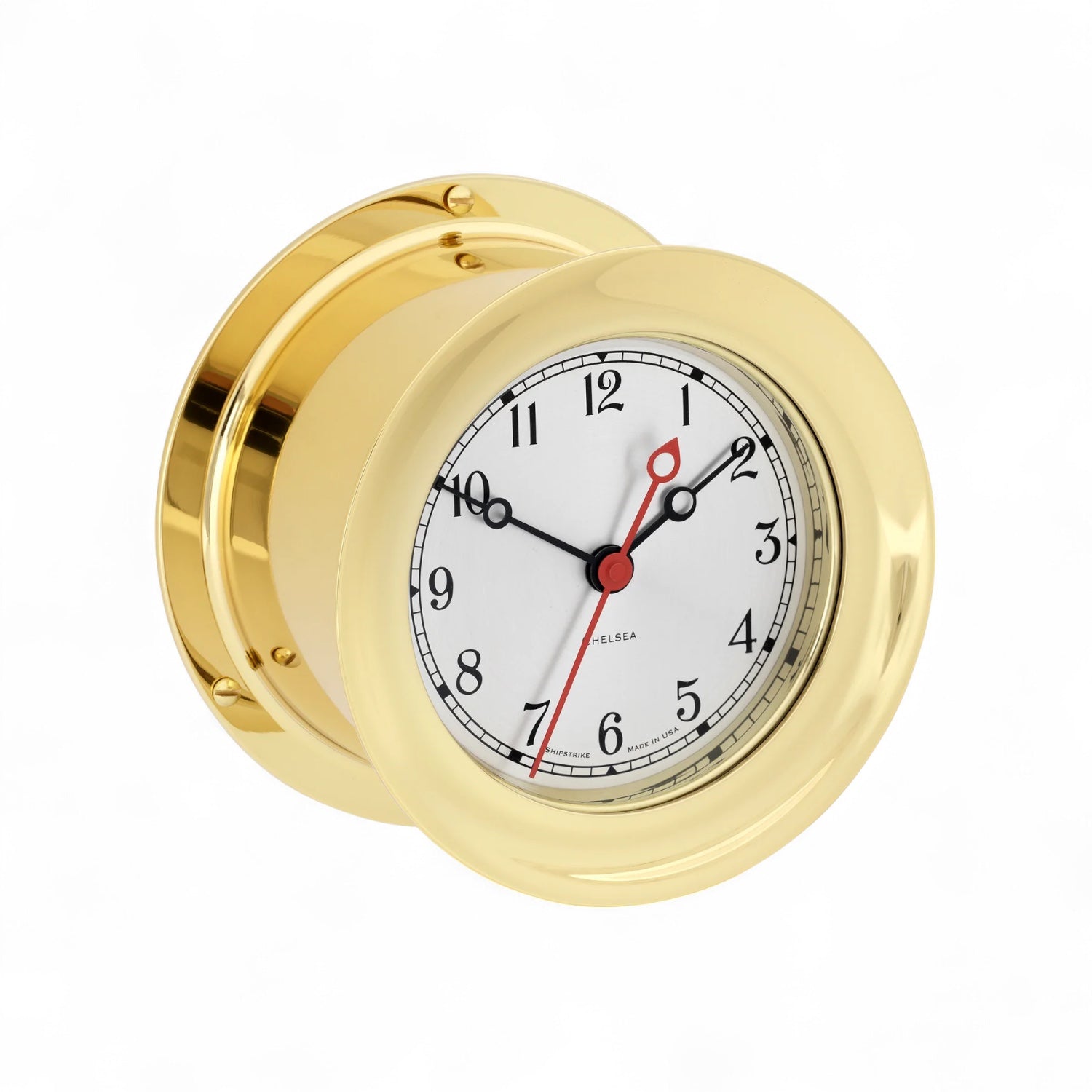
Chelsea Clock wandklok met scheepsbel 145 mm x 89 mm – quartz, rond, massief messing, luxe uitvoering
€1.325,00
Eenheid prijs PerChelsea Clock wandklok met scheepsbel 145 mm x 89 mm – quartz, rond, massief messing, luxe uitvoering
€1.325,00
Eenheid prijs PerOmdat deze klok met de precisie van een luxe horloge wordt vervaardigd, kies je met de Chelsea Clock Quartz scheepsklok met scheepsbel niet zomaar voor een gebruiksvoorwerp, maar voor een erfstuk dat generaties meegaat. Het massief gepolijste messing straalt klasse uit, terwijl het handgemaakte vakmanschap en het klassiek nautisch design de klok een tijdloze allure geven.
De scheepsbel van deze Chelsea Clock uit de Shipstrike serie, bootst het klassieke geluid van een ‘Ship’s Bell’ na, ook wel een glazenslaande klok genoemd, waardoor je bij ieder slagmoment de echte nautische sfeer ervaart. Dit model werkt op een betrouwbaar quartz Duits uurwerk met batterij, zodat je geniet van precisie zonder ingewikkeld onderhoud. Deze klokken heeft een aluminium wijzerplaat met geprinte zwarte Arabische cijfers en een rode secondewijzer. Het verschil met de Chelsea Clock 'Shipsbell' serie is dus het mechanisme. De buitenkant en materiaal is hetzelfde.
De klok is bedoeld voor binnengebruik, maar kan ook in een goed geventileerde kajuit worden opgehangen. Dankzij de afschroefbare bezel vervang je eenvoudig de batterij, en het messing behoudt zijn glans wanneer je het regelmatig oppoetst met een zachte doek.
Voor een persoonlijk tintje is er de mogelijkheid tot gravure op de kast of een plaquette (tegen meerprijs). Neem gerust contact met ons op voor de mogelijkheden. Kijk ook naar de optie om een basis van hout erbij te nemen, zodat je het op een schouw of bureau kunt plaatsen. Chelsea Clock instrumenten worden op bestelling samengesteld. Hierdoor ontvang je een uniek, speciaal voor jou geproduceerd item. Houd rekening met speciale ordervoorwaarden en levertijd.
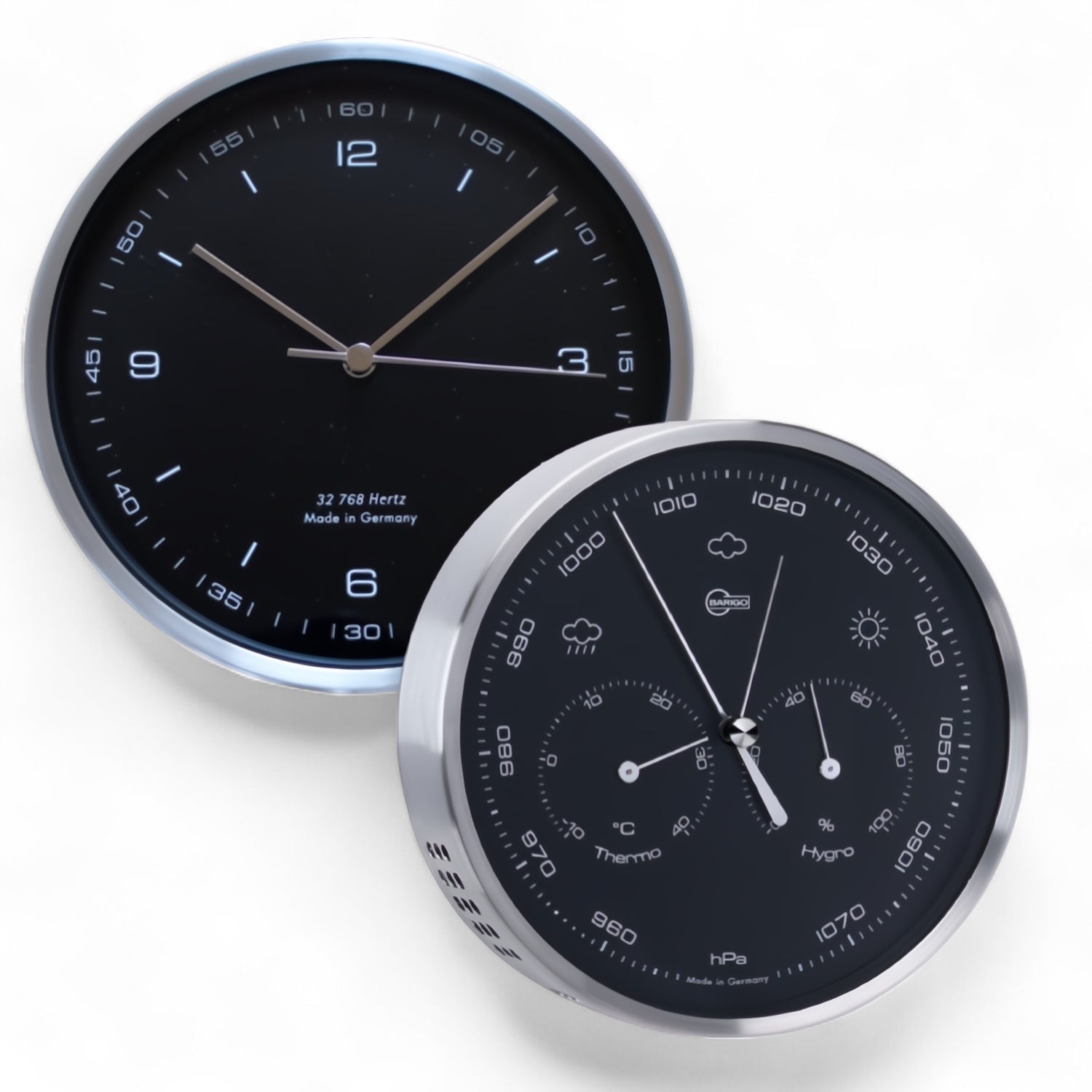
Barigo Steel set scheepsklok en weerstation 162mm - 350MBL + 650MBL, zwart, RVS
€578,00
Eenheid prijs PerBarigo Steel set scheepsklok en weerstation 162mm - 350MBL + 650MBL, zwart, RVS
€578,00
Eenheid prijs Per
Barigo Viking scheepsklok 155 x 35 mm – quartz, klassiek, hoogwaardig, stil uurwerk, 4 varianten
Vanaf €139,00
Eenheid prijs PerBarigo Viking scheepsklok 155 x 35 mm – quartz, klassiek, hoogwaardig, stil uurwerk, 4 varianten
Vanaf €139,00
Eenheid prijs PerDe Barigo Viking scheepsklok is de grootste klassieke klok uit de gerenommeerde Duitse fabriek. Met een imposante afmeting van 155 x 35 mm is het een statement aan boord of in huis. De 130 mm wijzerplaat is helder afleesbaar en verkrijgbaar in verschillende uitvoeringen: Arabische cijfers of een variant met radio-stilte zones. De hoogwaardige behuizing, in messing of gepolijst roestvrij staal, wordt subtiel geaccentueerd door een klein rond detail bij het midden van de wijzers. De 12-uurs en 24-uurs tijdsaanduiding combineert grote Arabische cijfers (1-12) met kleinere cijfers (13-24) eronder.
Voor een complete nautische set combineer je de klok met de bijpassende Viking barometer. Het stille quartz uurwerk, eveneens van Duitse makelij, zorgt voor nauwkeurige tijdweergave zonder storend getik—ideaal voor kajuiten, kantoren of serene woonruimtes.
Vervaardigd in Duitsland, met meer dan 80 jaar vakmanschap, is de Barigo Viking scheepsklok een robuuste en stijlvolle keuze voor liefhebbers van nautisch design en topkwaliteit.
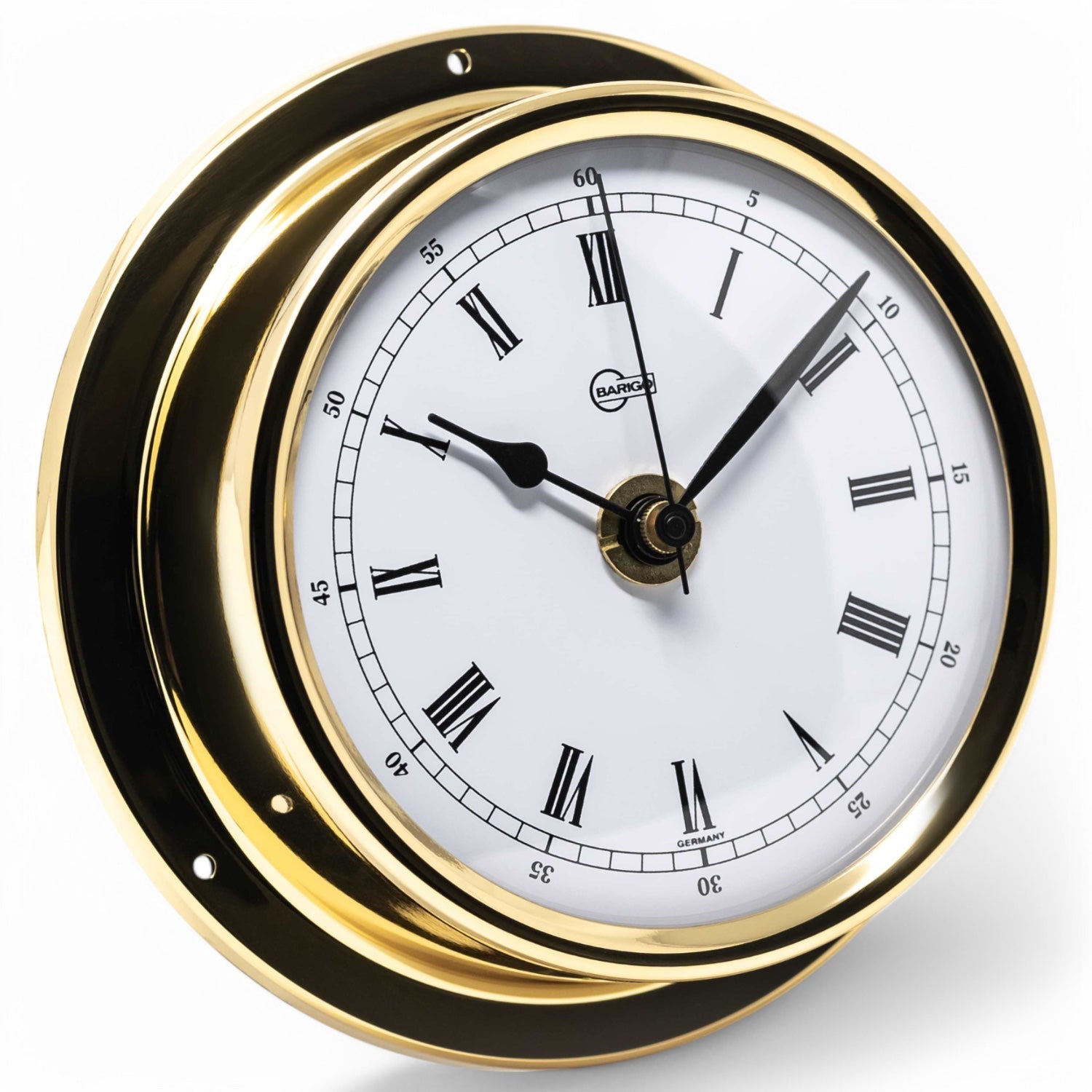
Barigo Regatta scheepsklok 120 x 40 mm – quartz, klassiek, hoogwaardig, stil uurwerk
Vanaf €169,00
Eenheid prijs PerBarigo Regatta scheepsklok 120 x 40 mm – quartz, klassiek, hoogwaardig, stil uurwerk
Vanaf €169,00
Eenheid prijs PerDe Barigo Regatta scheepsklok is een klassiek nautisch instrument, ontworpen in dezelfde stijl als de Tempo serie, maar dan voor degenen die net een maatje groter kiezen. Met een afmeting van 120 x 40 mm biedt deze klok een indrukwekkende uitstraling zonder concessies te doen aan het tijdloze ontwerp. De hoogwaardige afwerking in messing of gepolijst roestvrijstaal en het betrouwbare uurwerk maken het een uitstekende keuze voor zowel aan boord als in huis.
Deze scheepsklok heeft een stil quartz uurwerk dat zorgt voor een nauwkeurige tijdweergave zonder het storende getik, wat het ideaal maakt voor kajuiten, kantoren of andere rustige omgevingen. De Barigo Regatta staat garant voor betrouwbaarheid en vakmanschap, met een robuuste behuizing en een goed afleesbare wijzerplaat.
Hij is verkrijgbaar in kleur messing of verchroomd messing en met een wijzerplaat naar keuze: klassieke Romeinse cijfers, een moderne Arabische variant of een nostalgische radio-stilte. Barigo Regatta is een echte scheepsklok met een uitstekende prijs-kwaliteitverhouding. Met meer dan 80 jaar Duitse ervaring is de Regatta scheepsklok een uitstekende keuze voor liefhebbers van nautisch design, met een uitstekende prijs-kwaliteitverhouding.

Barigo Tempo scheepsklok 110 x 32 mm – quartz, klassiek, hoogwaardig, stil uurwerk
Vanaf €139,00
Eenheid prijs PerBarigo Tempo scheepsklok 110 x 32 mm – quartz, klassiek, hoogwaardig, stil uurwerk
Vanaf €139,00
Eenheid prijs PerDe Barigo Tempo scheepsklok is een icoon in de maritieme wereld. De hoogwaardige afwerking en het klassieke ontwerp maken deze klok tot een ware blikvanger. Het nautische uurwerk wordt in Duitsland vervaardigd en staat garant voor kwaliteit en betrouwbaarheid. Een stille, betrouwbare klok met een behuizing van 110mm en een helder afleesbare witte wijzerplaat van 85mm. Niet voor niets een van de best verkochte scheepsklokken. Dankzij het precieze quartz uurwerk loopt hij altijd nauwkeurig en doet hij dat zonder storend getik. Ideaal voor aan boord, in de kajuit of zelfs als stijlvolle toevoeging in huis.
Met meer dan 80 jaar Duitse vakmanschap staat deze klok garant voor kwaliteit en duurzaamheid. Hij is verkrijgbaar in messing of gepolijst roestvrijstaal en met een wijzerplaat naar keuze: klassieke Romeinse cijfers, een moderne Arabische variant of een nostalgische radio-stilte. Eenvoudige wandmontage met schroefopening aan de achterzijde. Barigo Tempo is een echte scheepsklok met een uitstekende prijs-kwaliteitverhouding.
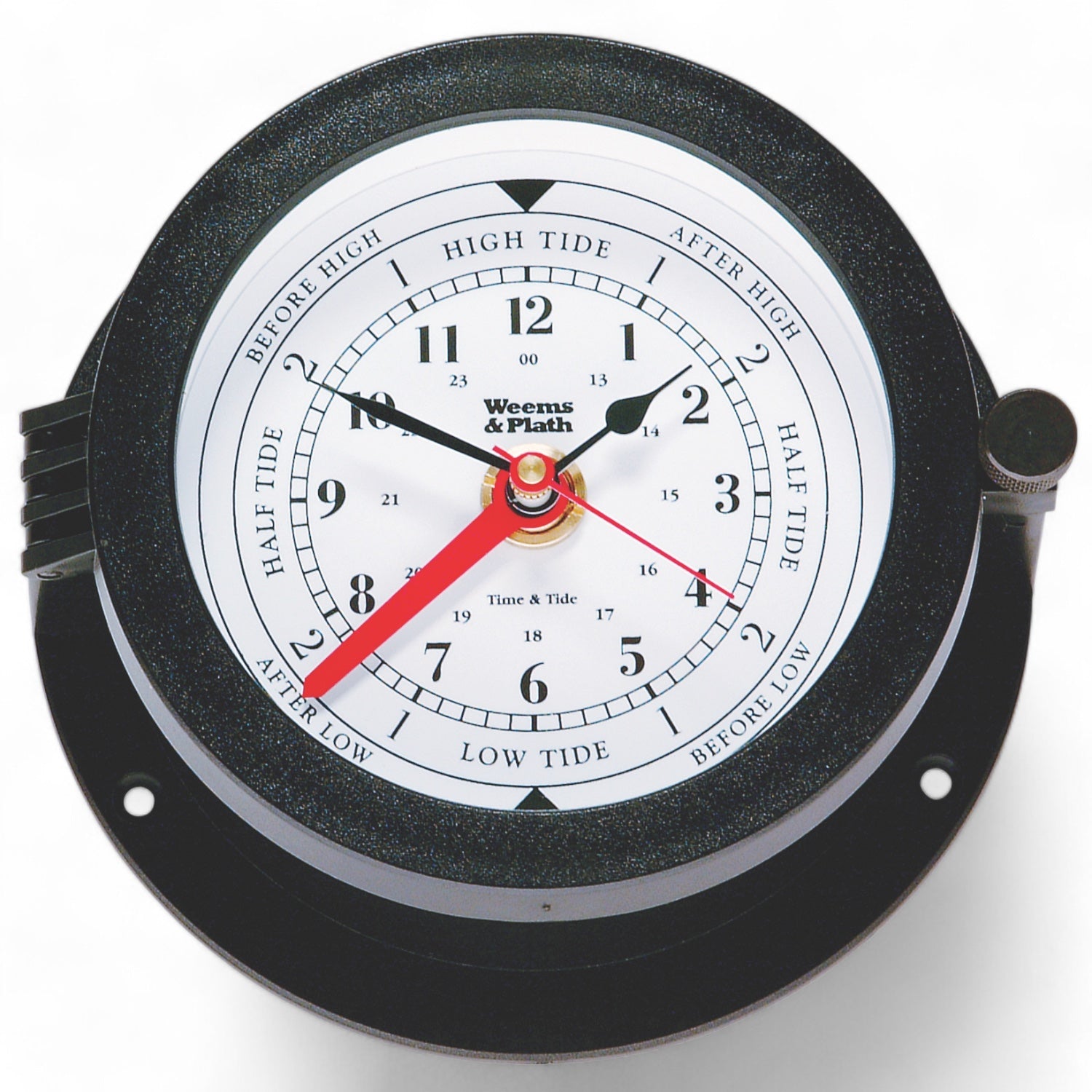
Bluewater getijdenklok 140 x 73 mm - onderhoudsarm, spatwaterdicht, betrouwbaar
€109,95
Eenheid prijs PerBluewater getijdenklok 140 x 73 mm - onderhoudsarm, spatwaterdicht, betrouwbaar
€109,95
Eenheid prijs PerDeze onderhoudsarme Weems & Plath Bluewater getijdenklok houdt de tijd van de zee bij met precisie en stijl. De rode getijdeaanduiding geeft snel inzicht in de stand van het tij, ideaal voor watersporters. Voor andere getijden-gebieden, zoals de Stille Oceaan of de Golf van Mexico, of elders kan kalibratie eenvoudig worden aangepast. De corrosiebestendige, spatwaterdichte behuizing van hoogwaardig zwart hars is ontworpen voor duurzaamheid. Met een moderne, tijdloze zwarte behuizing en een witte wijzerplaat is hij goed leesbaar. De matte afwerking voorkomt schittering en de O-ringafdichting beschermt tegen vocht. Inclusief montagemateriaal en duidelijke instructies. Betrouwbaar, onderhoudsarm en ontworpen voor wie altijd op koers wil blijven met de zee. Een uitstekende balans tussen kwaliteit en prijs. De ideale getijdenklok, waar je koers ook ligt.

Bluewater thermometer 140 x 73 mm - onderhoudsarm, spatwaterdicht, betrouwbaar
€99,95
Eenheid prijs PerBluewater thermometer 140 x 73 mm - onderhoudsarm, spatwaterdicht, betrouwbaar
€99,95
Eenheid prijs PerDeze onderhoudsarme Weems & plath Bluewater thermometer is de ideale keuze voor nauwkeurige temperatuurmetingen voor scheepvaart en bootliefhebbers, in zowel Fahrenheit als Celsius. Met markeringen elke 2 graden, van -10 °C tot 55 °C, is hij vooraf ingesteld in een gecontroleerde omgeving voor betrouwbare prestaties. De spatwaterdichte, corrosiebestendige behuizing van zwart hars en het krasbestendige glas maken hem perfect voor maritieme omstandigheden. De matte, schitteringsbestendige afwerking en de O-ringafdichting verhogen het gebruiksgemak. Met een moderne, tijdloze zwarte behuizing en een witte wijzerplaat is hij goed leesbaar. Dankzij de scharnierende ring met messing borglip stel je hem eenvoudig af wanneer nodig. Inclusief montage-instructies en de Weems & Plath levenslange beperkte garantie. Een praktische, stijlvolle aanvulling voor iedereen die vaart op precisie. Kwaliteit die betaalbaar blijft. Een moderne thermometer die met je meevaart, waar je ook bent.
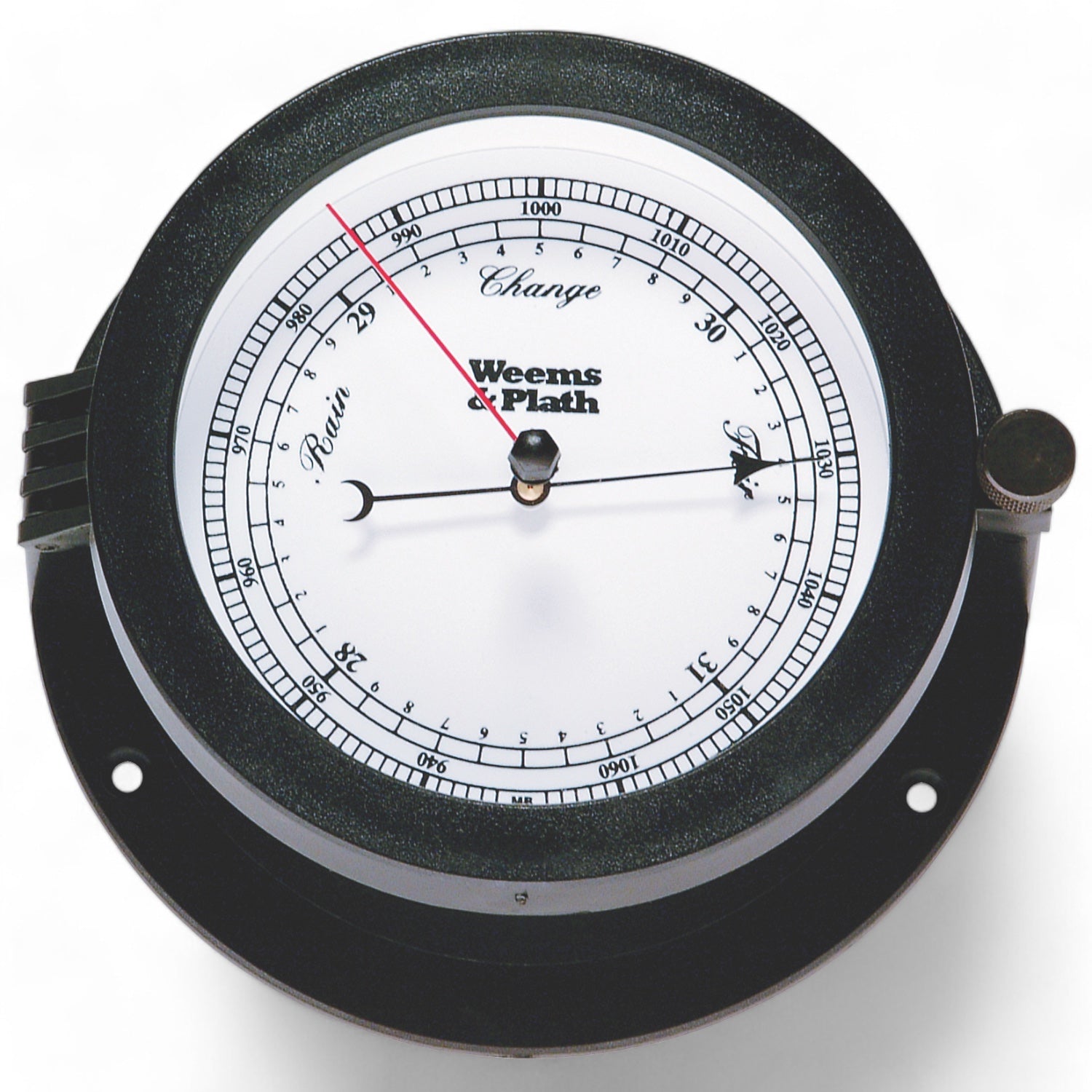
Bluewater barometer 140 x 73 mm - onderhoudsarm, spatwaterdicht, betrouwbaar
€99,95
Eenheid prijs PerBluewater barometer 140 x 73 mm - onderhoudsarm, spatwaterdicht, betrouwbaar
€99,95
Eenheid prijs PerDeze onderhoudsarme Weems & plath Bluewater barometer is perfect voor wie de zee en het weer serieus neemt. Met een volledig instelbaar, temperatuurgecompenseerd aneroïde mechanisme en duidelijke inch- en millibarschalen meet je nauwkeurig tot 1.500 voet boven zeeniveau. De spatwaterdichte, corrosiebestendige behuizing van hoogwaardig zwart hars maakt hem ideaal voor maritieme omgevingen. Met een moderne, tijdloze zwarte behuizing en een witte wijzerplaat is hij goed leesbaar. Het krasbestendige glas en de schitteringsbestendige matte afwerking zorgen voor duurzaamheid en optimaal gebruiksgemak. Dankzij de O-ringafdichting is de barometer extra goed bestand tegen vocht. Inclusief montagemateriaal, duidelijke instructies en de levenslange beperkte garantie van Weems & Plath. Praktisch en stijlvol, voor iedereen die het weer en de zee wil begrijpen. Een goede prijs-kwaliteit verhouding. Kortom, een perfecte moderne barometer voor iedere schipper.
Ook aan boord: populaire collecties
Veelgestelde vragen
Tien tips voor het kiezen van jouw perfecte scheepsklok
Wil je de tijd aan boord in stijl houden? Volg deze handige tips voor het vinden van de ideale scheepsklok, passend bij jouw wensen en ruimte.
1. Locatie is key.
Meet de ruimte waar de klok komt, en check of er plek is voor extra gadgets zoals een barometer of weerstation.
2. Let op de diameter.
De maat van de klok varieert van 72 mm tot 270 mm – kies de grootte die past bij jouw ruimte.
3. Afmeting van de wijzerplaat.
Een grotere wijzerplaat maakt de klok beter afleesbaar, dus kies een formaat dat bij je past. Mede afhankelijk van de beschikbare ruimte in je kajuit of woonkamer. En bedenk goed of je er nog een bijpassend nautische instrument wilt ophangen.
4. Functionaliteit.
Wil je alleen de tijd of ook extra’s zoals getijden, een stille klok of met een scheepsbel?
5. Kies je schaal.
Arabische of Romeinse cijfers, of een unieke wijzerplaat zoals de Corum vlaggen van de Wempe Regatta serie.
6. Quartz of mechanisch uurwerk?
Quartz is handig met een batterij, terwijl mechanische klokken met de hand opgewonden worden – een klassieker voor vakmanschap!
7. Jouw stijl.
Porthole, gesloten klok of een sportieve limited edition? Witte of zwarte wijzerplaat? Kleur van de behuizing? Kies wat jouw boot of maritieme stijl het beste aanvult. Het is een duurzame keuze, dus dat mag de investering best waard zijn.
8. Materiaal en gewicht.
Messing, RVS, aluminium of zelfs carbonfiber – het materiaal bepaalt niet alleen de look, maar ook het gewicht.
Een scheepsklok is een essentieel tijdinstrument aan boord, niet alleen om de tijd bij te houden, maar ook voor navigatie en getijden. Het helpt je de aankomsttijd te berekenen en wachttijden aan boord te beheren. Daarnaast is de scheepsklok een stijlvol onderdeel van je schip, goed zichtbaar vanuit verschillende hoeken. Meestal gemaakt van messing, verchroomd messing of RVS, zijn deze materialen bestand tegen corrosie en de vochtige omstandigheden op zee.
Scheepsklokken zijn speciaal ontwikkeld voor de maritieme omgeving en zijn daardoor robuust en bestand tegen de omstandigheden op zee, zoals schokken. Ze een nautisch ontwerp, zoals een klassieke scheepsstijl of een mechanisch opwindsysteem. Daarnaast bieden scheepsklokken functies zoals getijden- of dubbele tijdzones, die bij gewone klokken meestal niet te vinden zijn. Gewone klokken zijn vaker ontworpen voor gebruik in huis of op kantoor en zijn minder bestand tegen de ruwe omstandigheden op zee. De belangrijkste verschillen liggen dus in de materialen, het ontwerp en de functionaliteit.
Bij een aantal scheepsklokken worden schroeven meegeleverd om de klok direct op te kunnen hangen in de voorgeboorde gaatjes. Andere merken bieden een handig ophangsysteem met een wandplaat: bevestig eerst de wandbevestiging met schroeven en hang daarna de scheepsklok er eenvoudig overheen. Dit systeem maakt het aanpassen van de tijd, zoals voor tijdzones, getijden of zomer- en wintertijd, een stuk eenvoudiger.
Er zijn verschillende type mechanismen, waarvan wij er twee aanbieden bij Studio Maritime. Mechanisch uurwerk, wat werkt op een opwindsysteem. Typisch voor klassieke scheepsklokken en traditionele klokken. Vereist handmatig opwinden, meestal elke 7-8 dagen. En een quartz uurwerk, wat batterijen vereist, zeer nauwkeurig is en weinig onderhoud vereist.
Een glazenslaande klok is een traditionele scheepsklok met een scheepsbel. De bellen van deze scheepsklok volgen het traditionele schema van scheepswachten, die vier uur duren en zijn opgedeeld in acht
halfuren. Elk halfuur wordt aangegeven door één extra bel, oplopend van één bel
na het eerste halfuur tot acht bellen na vier uur, waarmee de wacht eindigt. Zo
kunnen bemanningsleden aan het aantal bellen horen hoe ver hun wacht gevorderd
is, zonder naar een klok te hoeven kijken, aangezien vier bellen bijvoorbeeld
twee uur na de start van een wacht betekent. Een glazenslaande klok is verkrijgbaar in een mechanisch (met opwind sleutel) of quartz uurwerk (op batterijen).
Een getijdenklok volgt de maancyclus en toont het moment van hoog- of laagwater. De wijzer bovenaan geeft hoogwater aan. De
wijzer onderaan geeft laagwater aan. De wijzer beweegt continu, zodat je kunt zien
of het water stijgt of daalt.
De unieke radioroom scheepsklok, met zijn iconische groene en rode stilte sectoren, neemt je mee terug naar de tijd van de vroege maritieme radio- en telegrafiecommunicatie. De klok heeft gekleurde sectoren die aangeven wanneer morsecode (rode sectoren) of radio-telegrafie (groene sectoren) actief is. Het werd gebruikt om de tijd van communicatie te synchroniseren, zodat radio-operators wisten wanneer ze moesten luisteren of zenden. Tegenwoordig is de scheepsklok met stille sectoren, ook wel radioroom genoemd, een waardevol verzamelobject voor liefhebbers van zeevaartgeschiedenis. Een uniek eerbetoon aan de vroege maritieme technologie. waarmee het een waardevolle plek verdient in jouw collectie.












